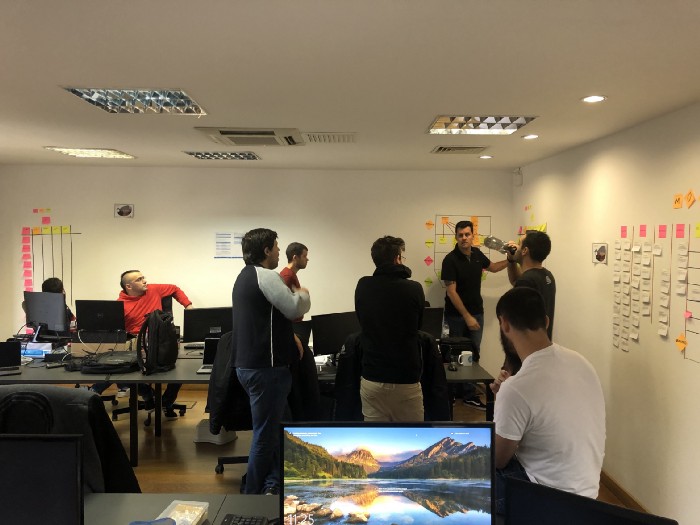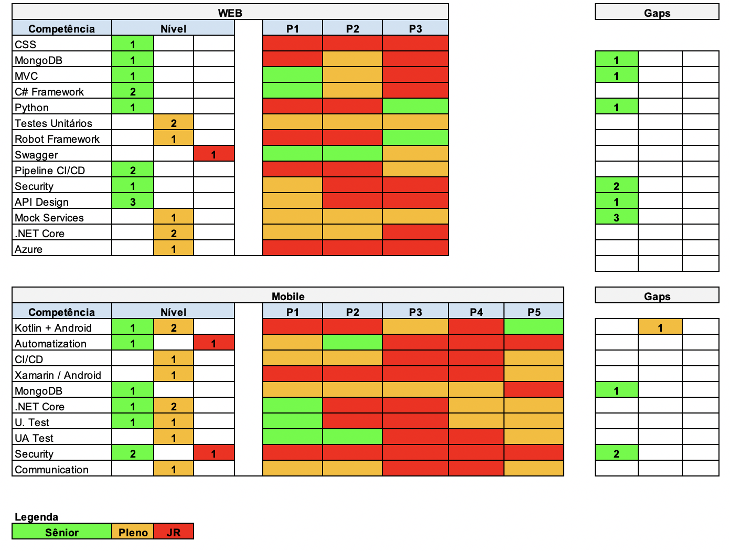

Hey everyone, how are you?
I will use the same rationale as in the previous article assuming that you already know the Team Competence Matrix of Management 3.0 but if you don’t, I share Tadeu Marinho’s article that explains the practice in a team that he ran the practice. 4 knowledge domains in Agility do Management 3.0 mas caso não conheçam, partilho o artigo do Tadeu Marinho que explica a prática em um time que ele rodou a prática
My goal is to bring a case of a client that I attended in Portugal in 2019 and ran the practice with 2 development teams.
Context
We were hired to do an Agile Assessment (using the 4 knowledge domains in Agility) of the development teams, understanding the day to day, points of improvement, bottlenecks, flow work and other additional information so that, together with the client, we talk about next steps and local and systemic improvements. 4 knowledge domains in Agility🙂 dos times de desenvolvimento, entendendo o dia a dia, pontos de melhorias, gargalos, fluxo de trabalho e outras informações adicionais para com isso, junto com o cliente falarmos de próximos passos e melhorias locais e sistêmicas.
We started the work talking to the teams that the purpose of the action was to understand how the company and the teams are organized, how they used agility and together, make improvements to help them be more effective (balance on Effectiveness and Effectiveness. You can listen our Podcast in Portuguese about this topic). Podcast em Portugês sobre esse tema.
Following the teams on a daily basis, the hypothesis arose that the teams were “siled”, working by specialties, that some technologies and / or tasks were not clear from who should or would know how to do them and that the attributions came from the “middle” managers ”.
Como Na agilidade praticamos transparência e visibilidade, conversei com as equipes e propus uma sessão de trabalho para montarmos a Matriz de Competência dos Times e vermos o resultado e ações da sessão e eles toparam. 😉
How did we do the session? Old School mode, we did it on the wall behind the teams’ tables!

Before starting the session I explained to them what the Competency Matrix is, what it is for, that it is not to fire anyone but to have a vision of how we are organized as a team and specialties and to know if they had the necessary skills for the demands that were working. And that with this information in hand, we would have visibility of the current state and work on an action plan and necessary improvements.
We also aligned the levels of competence that they would use in self-assessment. There are those who use “Shu-Ha-Ri”, there are those who use “Apprentice, Journeyman, Master” but in our case we did something simpler which was “Junior, Full and Senior”. OBS: The decision was made by the team, and it was legal because they organized themselves to reach a consensus.

Given that they had understood the purpose, content and dynamics, the teams started to work first by gluing post-its on the skills they have or should have and then adding the number of people and on what levels they should be by competence.
After completing this step, they started to do the self-assessment individually, but with a lot of exchange of ideas between them because when a person evaluated themselves as Junior (for example) in a certain specialty, another member of the team spoke up and said “you don’t it’s JR no, it’s more for Pleno because he already knows how to do this, that and etc ”.
As a result, little by little they were setting up the competence matrix, evaluating themselves but also receiving feedback from the team, which helped to better calibrate the levels of each person and by specialty.
What was the final result? According to the left table, we found some GAPS in some specialties that, in the team’s view, they did not have people with the necessary competence (yet).

Looking at this map, what action would you take? Simple, hire more people with the skills and levels we need, right? Wronnnnng (Brazilian meme)!!!!

With this information in hand, I talked to both the teams and their managers to start working together and with that, share knowledge between them and enable people to evolve as professionals, learning more about some new competence or something that they already have. does. Even a person who is already a Senior on some topic, manages to learn even more because teaching is a way of learning, in addition to having the opportunity to see another person develop something in a way different from yours.

Another issue that was legal is that it helped teams and managers to have visibility of tasks that needed people with more competence in a specialty that the team did not yet have and that could be a reason for some tasks that took longer than expected, as the team still had to learn something to develop later.
How has this helped the teams and the company on a daily basis?
Finishing, the Team Competency Matrix is a very simple yet powerful tool / practice to give visibility to the current state of the team and help in decision making, aligned with the company’s strategy and objectives that we want to achieve.
I’m happy to be able to share this case with you and if you want to talk more about it, I’m available.
See you soon ;-)
Ricardo Caldas
